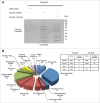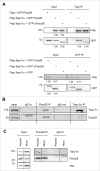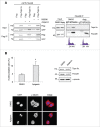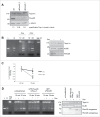Fbxo28 promotes mitotic progression and regulates topoisomerase IIα-dependent DNA decatenation
- PMID: 27754753
- PMCID: PMC5224455
- DOI: 10.1080/15384101.2016.1246093
Fbxo28 promotes mitotic progression and regulates topoisomerase IIα-dependent DNA decatenation
Abstract
Topoisomerase IIα is an essential enzyme that resolves topological constraints in genomic DNA. It functions in disentangling intertwined chromosomes during anaphase leading to chromosome segregation thus preserving genomic stability. Here we describe a previously unrecognized mechanism regulating topoisomerase IIα activity that is dependent on the F-box protein Fbxo28. We find that Fbxo28, an evolutionarily conserved protein, is required for proper mitotic progression. Interfering with Fbxo28 function leads to a delay in metaphase-to-anaphase progression resulting in mitotic defects as lagging chromosomes, multipolar spindles and multinucleation. Furthermore, we find that Fbxo28 interacts and colocalizes with topoisomerase IIα throughout the cell cycle. Depletion of Fbxo28 results in an increase in topoisomerase IIα-dependent DNA decatenation activity. Interestingly, blocking the interaction between Fbxo28 and topoisomerase IIα also results in multinucleated cells. Our findings suggest that Fbxo28 regulates topoisomerase IIα decatenation activity and plays an important role in maintaining genomic stability.
Keywords: Cell cycle; F-box protein; Fbxo28; SCF; Topoisomerase IIα; decatenation; mitosis.
Figures







Similar articles
-
Geminin overexpression prevents the completion of topoisomerase IIα chromosome decatenation, leading to aneuploidy in human mammary epithelial cells.Breast Cancer Res. 2011 May 19;13(3):R53. doi: 10.1186/bcr2884. Breast Cancer Res. 2011. PMID: 21595939 Free PMC article.
-
SRBD1 facilitates chromosome segregation by promoting topoisomerase IIα localization to mitotic chromosomes.Nat Commun. 2025 Feb 16;16(1):1675. doi: 10.1038/s41467-025-56911-w. Nat Commun. 2025. PMID: 39955279 Free PMC article.
-
Bloom's syndrome and PICH helicases cooperate with topoisomerase IIα in centromere disjunction before anaphase.PLoS One. 2012;7(4):e33905. doi: 10.1371/journal.pone.0033905. Epub 2012 Apr 26. PLoS One. 2012. PMID: 22563370 Free PMC article.
-
Topoisomerase IIα in chromosome instability and personalized cancer therapy.Oncogene. 2015 Jul 30;34(31):4019-31. doi: 10.1038/onc.2014.332. Epub 2014 Oct 20. Oncogene. 2015. PMID: 25328138 Free PMC article. Review.
-
The toposome: a new twist on topoisomerase IIalpha.Cell Cycle. 2004 May;3(5):627-8. doi: 10.4161/cc.3.5.822. Epub 2004 May 22. Cell Cycle. 2004. PMID: 15107612 Review. No abstract available.
Cited by
-
The Influences of Perinatal Androgenic Exposure on Cardiovascular and Metabolic Disease of Offspring of PCOS.Reprod Sci. 2023 Nov;30(11):3179-3189. doi: 10.1007/s43032-023-01286-w. Epub 2023 Jun 28. Reprod Sci. 2023. PMID: 37380913 Review.
-
Systematic analysis of the expression and prognosis relevance of FBXO family reveals the significance of FBXO1 in human breast cancer.Cancer Cell Int. 2021 Feb 23;21(1):130. doi: 10.1186/s12935-021-01833-y. Cancer Cell Int. 2021. PMID: 33622332 Free PMC article.
-
FBXO28 promotes cell proliferation, migration and invasion via upregulation of the TGF-beta1/SMAD2/3 signaling pathway in ovarian cancer.BMC Cancer. 2024 Jan 24;24(1):122. doi: 10.1186/s12885-024-11893-8. BMC Cancer. 2024. PMID: 38267923 Free PMC article.
-
FBXO28 suppresses liver cancer invasion and metastasis by promoting PKA-dependent SNAI2 degradation.Oncogene. 2023 Sep;42(39):2878-2891. doi: 10.1038/s41388-023-02809-0. Epub 2023 Aug 18. Oncogene. 2023. PMID: 37596321 Free PMC article.
-
Cellular TRIM33 restrains HIV-1 infection by targeting viral integrase for proteasomal degradation.Nat Commun. 2019 Feb 25;10(1):926. doi: 10.1038/s41467-019-08810-0. Nat Commun. 2019. PMID: 30804369 Free PMC article.
References
-
- Chen SH, Chan NL, Hsieh TS. New mechanistic and functional insights into DNA topoisomerases. Annu Rev Biochem 2013; 82:139-70; PMID:23495937; http://dx.doi.org/10.1146/annurev-biochem-061809-100002 - DOI - PubMed
-
- Heck MM, Hittelman WN, Earnshaw WC. Differential expression of DNA topoisomerases I and II during the eukaryotic cell cycle. Proc Natl Acad Sci U S A 1988; 85:1086-90; PMID:2829215; http://dx.doi.org/10.1073/pnas.85.4.1086 - DOI - PMC - PubMed
-
- Ishida R, Sato M, Narita T, Utsumi KR, Nishimoto T, Morita T, Nagata H, Andoh T. Inhibition of DNA topoisomerase II by ICRF-193 induces polyploidization by uncoupling chromosome dynamics from other cell cycle events. J Cell Biol 1994; 126:1341-51; PMID:8089169; http://dx.doi.org/10.1083/jcb.126.6.1341 - DOI - PMC - PubMed
-
- Oliveira RA, Hamilton RS, Pauli A, Davis I, Nasmyth K. Cohesin cleavage and Cdk inhibition trigger formation of daughter nuclei. Nat Cell Biol 2010; 12:185-92; PMID:20081838; http://dx.doi.org/10.1038/ncb2018 - DOI - PMC - PubMed
-
- Holm C, Goto T, Wang JC, Botstein D. DNA topoisomerase II is required at the time of mitosis in yeast. Cell 1985; 41:553-63; PMID:2985283; http://dx.doi.org/10.1016/S0092-8674(85)80028-3 - DOI - PubMed
MeSH terms
Substances
LinkOut - more resources
Full Text Sources
Other Literature Sources
